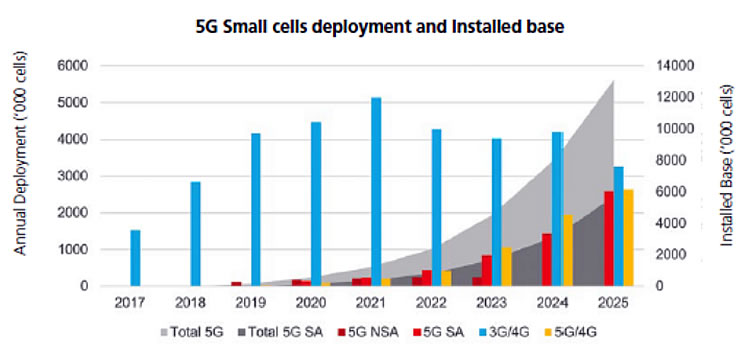Michelle Donegan is a tech writer who has covered the communications industry for more than 25 years on both sides of the pond. Having worked for various industry titles, including Communications Week International, Total Telecom and Light Reading, she specializes in mobile network technology trends.

Source: Small Cell Forum
Small cells are expected to feature prominently in 5G networks. A recently published ebook from CommScope provides a guide to small cell technology and solutions for overcoming deployment challenges.
As explained in the ebook, “Site Solutions for Techies,” small cells solve a lot of problems for mobile operators including, capacity, coverage latency and spectrum availability. Small cells are low-power, compact base stations that can be deployed indoors in homes, offices, shopping malls or other large venues (dubbed femtocells and picocells) or outdoors in discreet locations, such as mounted on lampposts or installed in bus shelters (these are called microcells or metrocells). They are faster to deploy and take up far less space than the traditional, large macrocell tower site.
Small cells not new or unique to 5G networks as mobile operators have rolled out the devices in their 3G and 4G networks for many years. According to the industry group, Small Cell Forum, 43% of small cells are deployed in areas that are not densely populated to fill coverage and capacity gaps in mobile networks. By 2025, most small cells (78%) are expected to be deployed in dense or hyperdense environments and the total installed base is expected to be 70.2 million small cells.
Small cells augment mobile networks in a number of ways:
- Boost Capacity. Operators can increase capacity at busy indoor locations by deploying small cells to supplement Distributed Antenna System (DAS) infrastructure. In outdoor scenarios, the capacity enhancement capabilities of small cells can contribute the higher speeds of 5G and Gigabit LTE, with the help of higher MIMO schemes, support for multiple frequency bands and resource sharing.
- Extend Coverage. With residential and enterprise small cells that use existing Internet connections for backhaul, operators can ensure customers always have a mobile signal even when indoors. For outdoor deployments in urban areas, small cells equipped with omni antennas can also extend signals indoors.
- Lower Latency. Low latency is one of the main advances of 5G technology, and it is enabled to a large extent by edge computing – the closer network processing is to the end user, the lower the latency times. Small cells deployed in a edge computing site will drive down latency. One of the challenges in edge scenarios is protecting the physical equipment. Operators will want hardened, ruggedized fiber connections that are easy to deploy, for example.
- Spectrum Offload. Thanks to small cells’ tighter frequency re-use which generates extra capacity, operators can offload traffic from busy areas to relieve congestion, improve service quality and use spectrum more efficiently. Small cells will need to support multiple bands – including 4G bands, 5G bands such as millimetre wave and C-band, as well as unlicensed bands to support operators’ offloading strategies.
Ofcom’s next 5G spectrum auction could finally deliver on 5G’s full potential
Ofcom has laid out its plans for the auctioning of 26GHz and 40GHz mmWave 5G spectrum.









